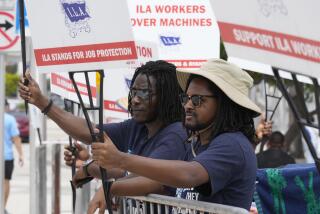Sunshine at the Waterfront
President Bush described a tentative settlement to the long-running labor dispute at West Coast ports as “good for workers, good for employers and ... good for America’s economy.” That’s usually a meaningless political cliche; this time, happily, it’s accurate.
Hope for a quick solution had been dashed in October when shipping lines and terminal operators locked out port workers for 10 days. The Bush administration properly used the Taft-Hartley Act to win a court order that reopened 29 West Coast ports, including Long Beach and Los Angeles.
Nobody knew what would happen when the order expired Dec. 27. So imagine the surprise late Saturday night when the collective bargaining process -- thought by many to be as dead as the dinosaurs -- led to an unexpected six-year labor agreement that will serve as a template for negotiations beginning in 2004 at East Coast and Gulf Coast ports.
Federal mediators deserve credit for tirelessly pushing the International Longshore and Warehouse Union and the Pacific Maritime Assn., which represents shipping lines and terminal operators, to stop bickering and start negotiating. The AFL-CIO, which counts the ILWU as a member, was so concerned about the mediation process succeeding that it sent its secretary-treasurer, Richard Trumka, to San Francisco to take part. Top management ended up praising the negotiations.
There are no guarantees that the Pacific Maritime Assn. won’t be back in six years asking for more concessions, or that independent-minded longshore workers won’t reject the settlement in an upcoming vote. But the hard-fought agreement suggests that labor and management leaned heavily on their long, shared history of negotiating solutions -- most notably a landmark 1960 agreement that paved the way for huge cranes and cargo containers that have reshaped the ports.
Port management won what it failed to get in two past negotiations -- the right to introduce bar-code scanners and other labor-saving technology, a move that will eliminate hundreds of union jobs. The union in return won significant pension plan improvements and modest wage hikes.
Flash back 30 years, when labor unrest last shut down West Coast ports and the economic effect barely registered outside the harbor front. Those ports now handle more than $310 billion in seagoing trade annually, so October’s lockout was from the start more than a local dispute. With this agreement, management and the union delivered a solution that will have positive repercussions well beyond the waterfront.
More to Read
Inside the business of entertainment
The Wide Shot brings you news, analysis and insights on everything from streaming wars to production — and what it all means for the future.
You may occasionally receive promotional content from the Los Angeles Times.










